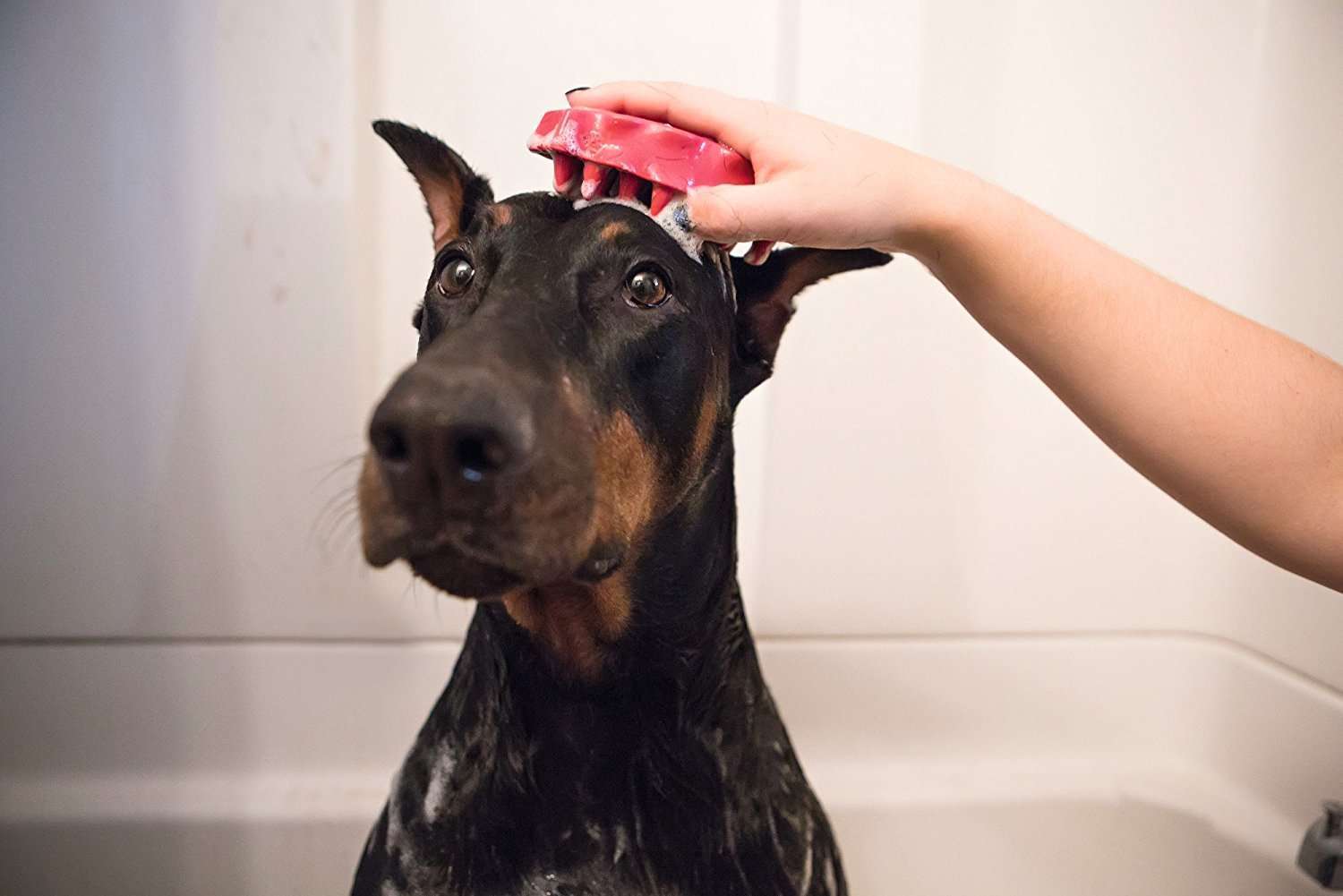Such clean dogs rarely require bathing, but situations do arise that call for a good washing. If you plan to show your Doberman, baths are an important part of grooming preparation. Your dog may occasionally like to roll in smelly matter to cover up his own scent, and there is always the chance he may, heaven forbid, come into contact with a skunk.
If you use your dog for therapy work or other activities that involve close contact with people, baths can help keep your dog smelling good. They can also minimize hair shedding, which always becomes more pronounced when the hair is worked up from petting and handling. If you allow your Doberman on the furniture or bed, or if you have young children in the house, cleanliness may be a greater concern.
Where to Bathe Your Doberman
The problem with bathing a Doberman is his size. The bathroom tub can make a suitable wash station when fitted with rubber footing to prevent slipping and to protect the tub from scratches. A hose with a spray head is available at many pet supply outlets and can easily be fitted to the shower pipe. A stationary tub in the basement may also suffice if it is large enough and if it is fitted with a rubber mat and spray hose.
Another option is to rent a bath station at a local boarding or training facility. These often have full-size tubs for bathing as well as blow-drying equipment. And finally, you might consider using the services of a professional pet groomer to do the job. It may be more expensive, but how much are you willing to pay to avoid the mess and hassle? Perhaps dog hair in your tub doesn’t appeal to you.
Maybe you don’t like getting as wet as your dog each time you have to bathe him. If having your dog spray water all over your house when he shakes really turns you off, or if you just plain don’t have the time, by all means, don’t hesitate to contact a professional.
Bathing Tips
Assuming you choose to keep your money in your pocket, bathing your dog at home is a reasonable choice. Washing him doesn’t have to be any more complicated than wetting the fur with lukewarm water, working up a good lather of shampoo, and then rinsing it out thoroughly. But you can do a few things to make bathing a little easier on you and your dog.
First, begin by wetting your dog’s feet and legs to give him a chance to adjust to the water temperature. Then wet the rest of his body from the belly up and from the rear to the neck. Keep his head dry until you are ready to wash it. This has a distinct advantage because as soon as your dog’s ears get wet he will attempt to shake. You can avoid taking a shower during his entire bath if you save his head for last.
After shampooing and thoroughly rinsing the body, begin to wet your dog’s head. If you hold his nose down while wetting, it will prevent water from running into it and making him uncomfortable. Avoid getting water into the ears—professional groomers often use cotton balls to keep water out of the ears during baths—because moisture in the ears contributes to the breeding of bacteria that cause ear infections.
Shampoo can be irritating to your dog’s eyes, so keep suds away from them and be sure shampoo doesn’t run into them when rinsing. When the body and head have both been shampooed and rinsed, squeeze excess water from the coat by running your hands along your dog’s body and down his legs (a small rubber squeegee works well for this, too). Then, a quick wrap with a towel will prevent that awful shaking from turning your house into a rain forest.
Numerous dog shampoo products are on the market, and you may want to experiment with them to find those that give the best results. You can also ask groomers or dog show exhibitors which products they prefer. There are color-enhancing shampoos, flea and tick shampoos, tearless shampoos, and shampoos for dogs with allergies or sensitive skin. Choose a shampoo for your dog’s particular needs, but never use human shampoos. They are not formulated for a dog’s skin and coat type, and can be exceptionally irritating if they get into his eyes.
Drying
The Doberman’s short coat does not have a sponge-like undercoat to soak up and hold moisture, so it dries relatively quickly on its own after a good towel rub and light brushing. Blow drying is generally not necessary unless it is a priority to get your dog dry as quickly as possible. You do not want to let your wet Doberman out in frigid weather, and if you don’t like damp spots left on the carpeting where he lies, you can blow dry him with a regular hair dryer on a low setting.
Blow drying can help dry your dog quickly and can also blow out a lot of dead hair during shedding season. The only problem with blow drying a Doberman is that it tends to fluff up the hair and sacrifices some of the sleekness that is the breed’s trademark. If you do blow dry your dog, be patient while he gets accustomed to the noise and air force. Never blow directly into your dog’s face or ears; these areas are best left to air dry.

